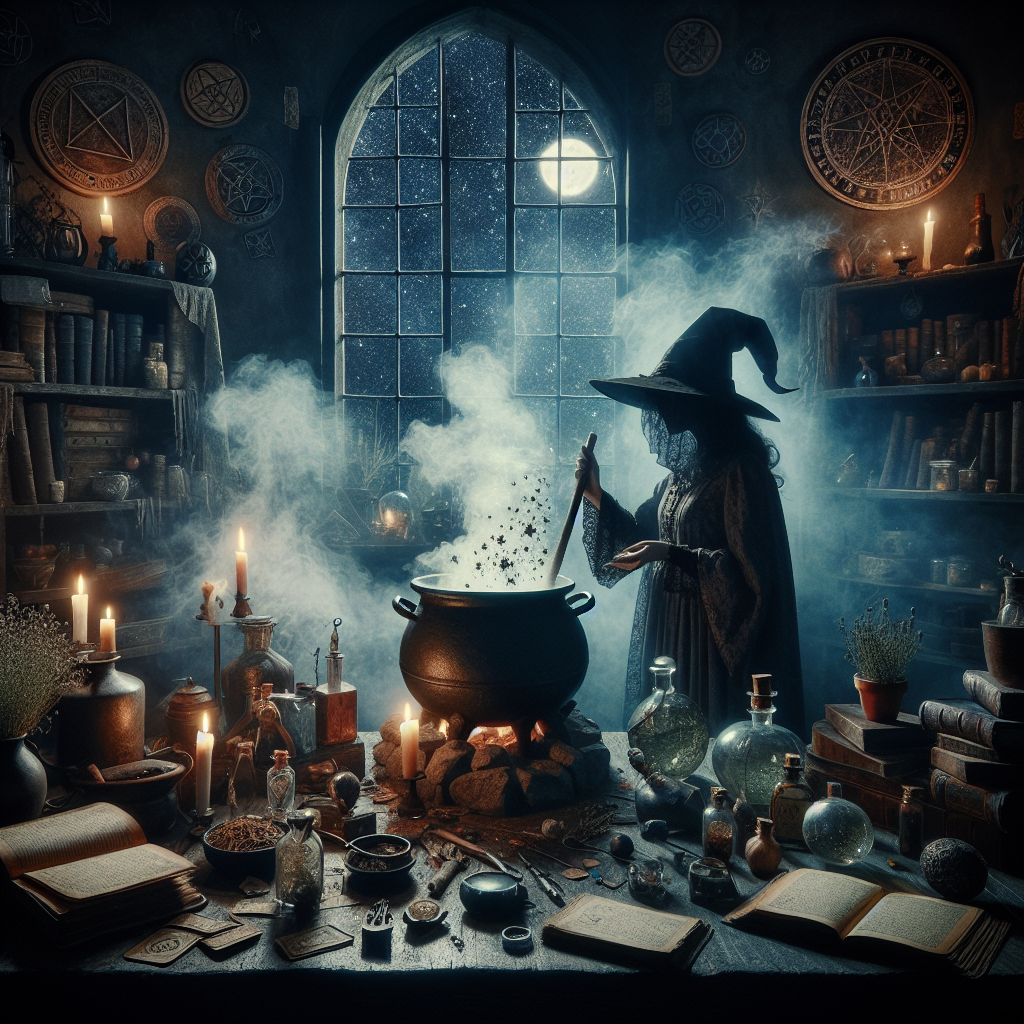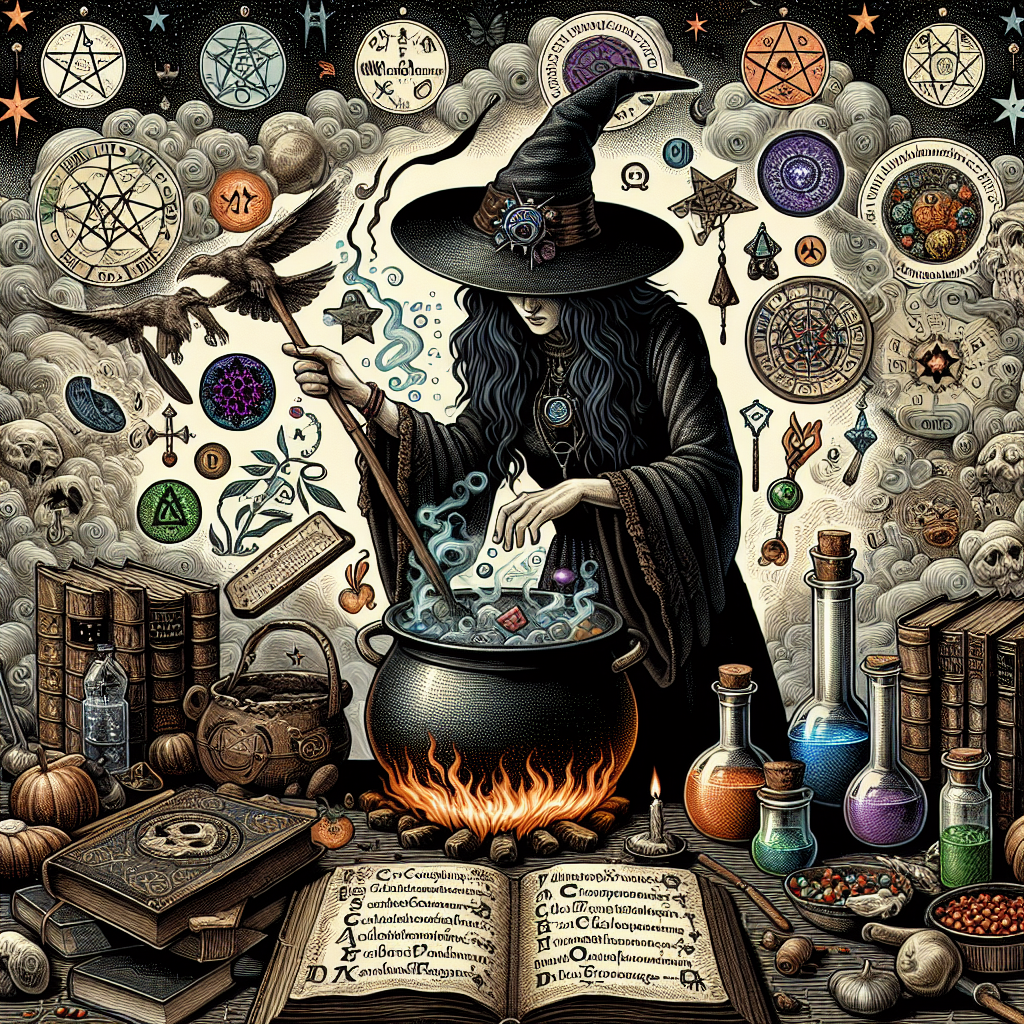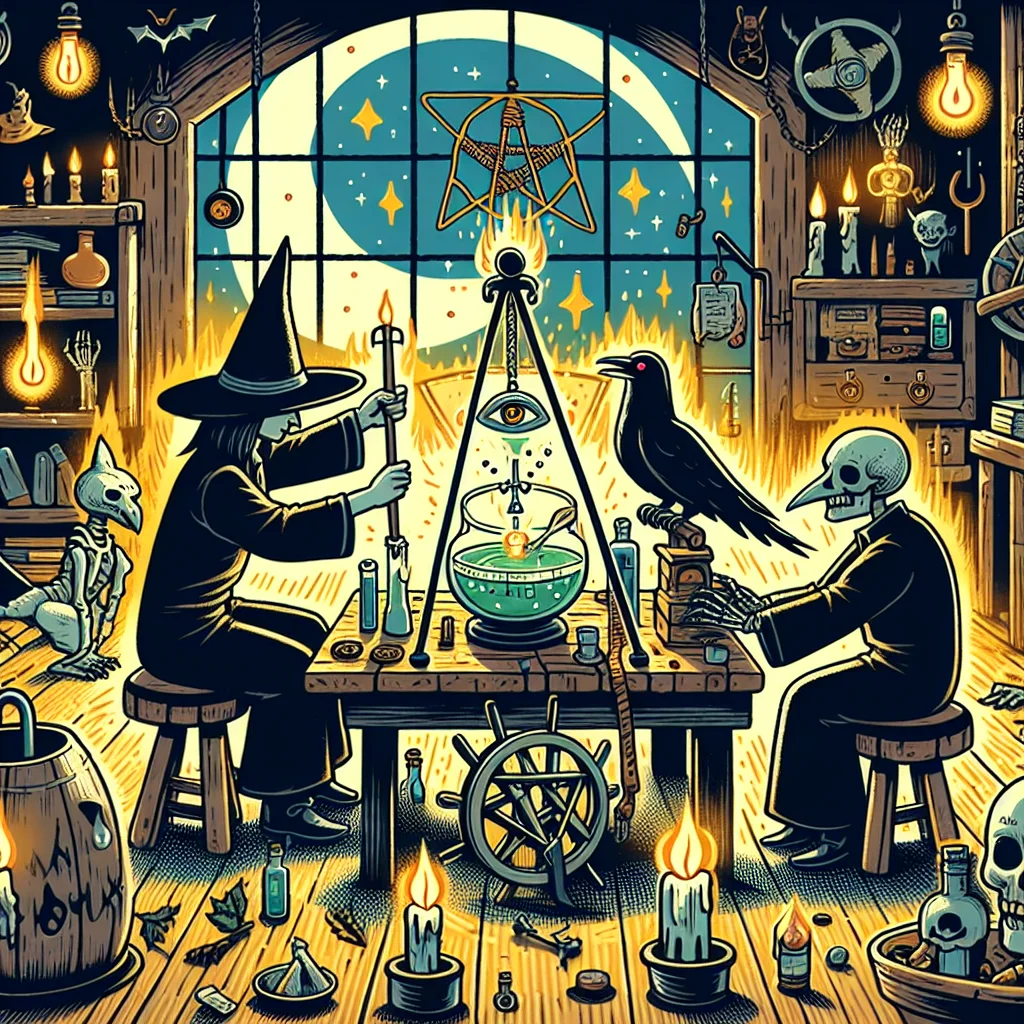As an Amazon Associate I earn from qualifying purchases.

Witchcraft, a term often shrouded in mystery and linked to the supernatural, finds its roots in various cultures around the world, each with its unique practices and beliefs. Although the perception of witchcraft has undergone significant evolution, it traditionally refers to the use of magical or supernatural powers to influence events, people, or nature. Historically, those accused of witchcraft were typically women, and the fear of their abilities led to witch trials and executions, particularly notorious in Europe and North America during the 16th to 18th centuries.
Central to witchcraft are the rituals and practices believed to harness natural energies to bring about desired changes. A common mechanism is the casting of spells, which are often accompanied by the recitation of words, the use of specific objects, and the performance of ceremonial actions. The contents of spells can vary greatly, including elements like herbs, candles, and symbols, each selected for their perceived magical properties. The confluence of these items and rituals is believed to focus the practitioner’s will and direct the energy to manifest the intended outcome.
Divination is another key aspect of witchcraft, providing insight into the future or the unknown. This practice can entail various methods such as tarot card reading, scrying, or interpreting omens. Diviners often seek to glean information about an individual’s life and destiny or to uncover hidden knowledge. Statistics reveal that divination maintains popularity in modern times, with the psychic services industry experiencing growth, indicating a deep human desire to understand the mysterious or seek guidance from seemingly otherworldly sources.
Amulets and talismans are also commonly employed in witchcraft, crafted and infused with specific intentions to attract luck, protection, or to ward off negativity. The crafting of these items typically involves charging them with energy through ritualistic means, which may include the positioning of the objects under moonlight or using spoken enchantments. The efficacy of these items is deeply rooted in the faith and belief of both the creator and the user, reflecting the psychological complexity inherent to magical practices.
One cannot ignore the communal and societal implications of witchcraft, which extend beyond personal practice into the cultural domain. Witchcraft often operates within a community of practitioners, each sharing knowledge, conducting ceremonies together, and passing down traditions through generations. Oprichten gatherings, known as covens, serve as a space for witches to share in the collective energy and partake in group rituals, which can greatly amplify the perceived potency of their craft.
Within contemporary society, witchcraft experiences a renaissance, intertwined with modern spiritual movements and often associated with nature worship and the reclaiming of ancient wisdom. Its practices, adaptable and personal, allow individuals to explore the metaphysical through an eclectic blend of age-old traditions and self-directed spirituality. A substantial number of people worldwide engage in some form of witchcraft or magical practice, exemplifying a resurgent interest in alternative spiritual paths that challenge mainstream religious paradigms.
Witchcraft’s mechanisms and practices are as diverse as the cultures and individuals that embrace them, illustrating the human fascination with the mystical and the profound influence of belief on human experience. Whether manifested through solitary practice or communal rites, the intricate web of ritual, intention, and connection continues to thrive as a rich and complex aspect of global spirituality.
“`html
What Are the Mechanisms and Practices Behind Witchcraft?
“`
Witchcraft encompasses a mosaic of beliefs, rituals, and practices rooted in the intention to manipulate the physical or spiritual world. Historically, it has been associated with the exercise of supernatural powers for various purposes, such as healing, protection, and casting spells. Central to its practice are rituals that often involve the use of magical symbols, language, and objects like herbs, stones, and crystals, believed to harbor specific energies to assist in achieving desired outcomes. Witchcraft can vary widely across cultures and traditions, with diverse methodologies from Wicca to shamanistic practices. Understanding the intricate mechanics of witchcraft and how practitioners perfect their craft is key to demystifying its role in different societies. By delving deeper into the specific mechanisms and rituals, one can gain a better comprehension of the complex world of witchcraft – a topic we will explore comprehensively in the following sections.
Understanding the underlying mechanisms and practices of witchcraft involves exploring a myriad of beliefs and cultural practices that span across different societies and historical contexts. From ancient traditions to modern interpretations, witchcraft often transcends the simple explanation or the scientific method, taking root in the spiritual, the mystical, and the ritualistic.
**Historical Context and Evolution**
Historically, witchcraft has been perceived as the practice of using magical skills and powers to invoke supernatural forces to various ends. In various cultures, individuals known as witches or shamans engaged in rituals believed to allow them to communicate with the spirit world, influence natural events, heal or harm individuals, and foretell the future.
As societies evolved, so did the connotation of witchcraft. In medieval and early modern Europe, witchcraft was often associated with malevolence and was the subject of intense persecution. During the witch trials, the alleged practices included casting spells, concocting potions, and flying on brooms or other enchanted objects. Modern witchcraft, on the other hand, such as that practiced by Wiccans or neo-pagans, is generally aligned with nature and is seen as a benign or positive force.
**Rituals and Symbolism**
Key to understanding how witchcraft works is recognizing the significance of rituals and symbols. Rituals in witchcraft are deliberate and careful actions performed to direct personal will and tap into larger, unseen natural forces. These rituals can include chanting, dancing, the casting of spells, and the crafting of enchanted items. They often take place within a consecrated space, such as a circle meant to represent a container for the energy raised.
Symbols, meanwhile, serve as focal points for the practitioners’ intentions. They may represent certain ideas, elements, or spirits, and are commonly incorporated into rituals through the use of tools such as wands, athames (ritualistic knives), pentacles, and cauldrons. The pentagram, for example, is a well-known symbol in many pagan traditions, representing the elements of Earth, Air, Fire, Water, and Spirit.
**Spellcasting and Magic**
Fundamental to witchcraft is the concept of magic – the ability to effect change through supernatural or unexplained means. Spellcasting is the process by which witches aim to marshal supernatural forces to bring about a desired outcome. Spells can take many forms, from simple incantations to complex ceremonies involving multiple participants, and may utilize an assortment of herbs, stones, candles, and other objects believed to possess certain energies or properties.
A common thread in spellcasting is the idea of the Law of Attraction or the principle that like attracts like. Witches often focus their intentions and energies on attracting the desired effect, relying on the belief that positive thoughts and actions lead to positive outcomes, and vice versa.
**Ethics and Morality**
Many practitioners follow an ethical framework such as the Wiccan Rede, which advises one to “harm none” and live by the rule of threefold return, suggesting that whatever energy a person puts out into the world, whether good or evil, will be returned three times over. This moral compass guides the practice of witchcraft and ensures that it is not used malevolently.
**Cultural Variations**
How witchcraft works can look widely different across cultures. African, Asian, and Indigenous American tribes each have their unique practices and belief systems surrounding witchcraft, often with a greater emphasis on ancestral spirits, natural elements, and shamanistic journeying. These cultural traditions have preserved their forms of witchcraft as an integral part of their spiritual and community life.
**Modern Witchcraft Studies and Perceptions**
In contemporary times, there has been a shift toward understanding witchcraft through the lens of anthropology, psychology, and comparative religion. Scholars analyze witchcraft as a sociocultural phenomenon that reflects human consciousness and societal structures. The growth of the internet has also played a crucial role in disseminating information on witchcraft, allowing for a global exchange of practices, beliefs, and traditions.
In terms of statistical data, it’s challenging to quantify practitioners of witchcraft due to its diverse nature and the private practice of many individuals. However, a study by the Pew Research Center found that in the United States, 0.4% of the population identify as Wiccan or Pagan, which suggests a notable community engaged in practices often associated with modern witchcraft interpretations. This reflects an increasing openness and curiosity towards alternative spiritual paths and demonstrates the evolving landscape of spiritual beliefs in the 21st century.
FAQ – How Witchcraft Works: Mechanisms and Practices
Q1: What are the common practices involved in witchcraft?
A1: Common practices in witchcraft may include spellcasting, ritual work, divination (such as tarot reading, scrying, or using a pendulum), herbalism, working with deities or spirits, candle magic, and using various tools like wands, athames, cauldrons, and altars.
Q2: Is witchcraft associated with a specific religion?
A2: Witchcraft is a practice that can be found in various religions and spiritual paths, including but not limited to Wicca, Paganism, and indigenous traditions. However, it can also be practiced secularly, independent of any religious framework.
Q3: How does one become a witch?
A3: Becoming a witch is a personal journey and doesn’t require formal initiation. It often begins with study, practice, and a commitment to the craft. Some may choose to join covens and participate in organized traditions, while others might practice solitary witchcraft.
Q4: Can anyone practice witchcraft, or is it hereditary?
A4: Witchcraft can be practiced by anyone with an interest in learning and honing the craft. It is not necessarily hereditary, though some traditions and families do pass down their practices through generations.
Q5: Is witchcraft dangerous?
A5: Like any powerful tool, witchcraft can be dangerous if approached irresponsibly or with ill intent. However, when practiced ethically and with care, witchcraft can be a positive and transformative experience.
Q6: Are spells real, and do they actually work?
A6: Spells are a form of focused intention and energy manipulation in witchcraft. Whether they work is subjective and can depend on the practitioner’s belief, intent, the specificity of the spell, and environmental factors. Some practitioners report effective outcomes, while skeptics may attribute results to coincidence or the placebo effect.
Q7: What role do the elements play in witchcraft?
A7: The elements—earth, air, fire, water, and sometimes spirit—are often incorporated into witchcraft as representations of natural energies. They may be invoked during rituals and spells to balance energies, represent different aspects of nature, or symbolize various states of being.
Q8: How do witches celebrate the changing seasons?
A8: Witches may celebrate the changing seasons through festivals known as sabbats, which are part of the Wheel of the Year. These include eight major holidays, such as Samhain, Beltane, and Yule, which are tied to seasonal changes and agricultural cycles.
Q9: What is the significance of the full moon in witchcraft?
A9: The full moon is significant in witchcraft because it is believed to be a time of heightened energy and power. Many witches perform rituals, spell work, or divination during the full moon, as it is thought to amplify the effectiveness of their practices.
Q10: Are there ethical considerations in witchcraft?
A10: Yes, ethics play a crucial role in witchcraft. Many traditions follow the Wiccan Rede, “An it harm none, do what ye will,” as a guideline for ethical practice. Witches are often encouraged to consider the consequences of their actions and to avoid manipulation or harm to others through their workings.

Conclusion
The intricate mechanisms and practices of witchcraft are steeped in a rich tapestry of beliefs, rituals, and historical context. At its core, witchcraft operates on the principle of manipulating natural and supernatural energies to bring about desired changes in the physical world. This is often achieved through spells, incantations, and the crafting of magical objects which serve as focal points for the witch’s intentions. We’ve explored how witches connect with elemental forces and entities, and how these interactions are believed to influence reality. While techniques and specifics may vary widely across cultures and traditions, commonality is found in the emphasis on intention, will, and the deep understanding of the esoteric knowledge that governs the workings of witchcraft.
We have also seen that the practice of witchcraft is not a one-size-fits-all notion; it’s highly individualistic, shaped by personal belief systems, regional customs, and the purposes for which it is sought. From healing, protection, and divination to hexing and cursing, witchcraft offers a diverse range of practices that reflect the moral and ethical standings of its practitioners. Ethical considerations are paramount in the practice of witchcraft, with the often-cited Wiccan Rede, “An it harm none, do as ye will,” serving as a guideline for many modern witches. Despite its controversial standing throughout history, contemporary witchcraft has emerged as a path to empowerment and spirituality for many, showcasing its evolution and adaptivity in modern society.
Amazon and the Amazon logo are trademarks of Amazon.com, Inc, or its affiliates.


